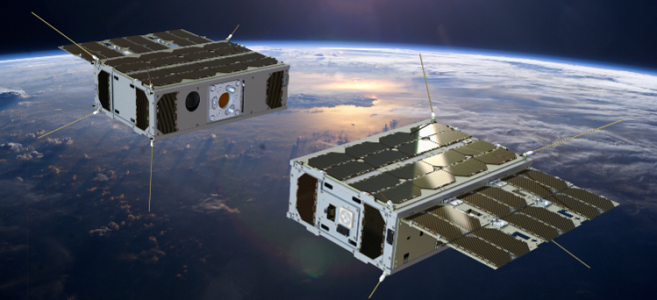Rendezvous Autonomous Cubesats Experiments (RACE) Mission Phase A/B
Programme
GSTP
Programme Reference
G637-009SY
Prime Contractor
GMV INNOVATING SOLUTIONS SP. Z O.O.
Start Date
End Date
Status
Closed
Country
Poland

Objectives
The objective of this activity is to define the Rendezvous Autonomous Cubesats Experiment (RACE) IOD CubeSat mission/system requirements and preliminary design baseline with supporting trade-offs, analyses and breadboarding (as necessary) in order to confirm the technical feasibility, operations concept, and programmatics for a follow-on implementation phase (including system development plan, cost, schedule and consortium composition).
Description
RACE has been conceived by ESA as a low-cost IOD mission in low Earth orbit to demonstrate the capability of nano-satellite systems (following the CubeSat form factor) to perform close proximity operations relative to cooperative targets (rendezvous and docking) and optionally uncooperative targets (pose estimation and close fly around) using the following critical miniaturised technologies currently under development in Europe:
- relative navigation sensors (visual camera, differential GNSS, laser range finder/LiDAR)
- relative control actuators (propulsion system for 6 DoF fine control)
- docking mechanisms (soft and hard docking systems)
These critical technologies are expected to reach a sufficient level of maturity by the RACE system PDR.
In addition, RACE shall act as an in-orbit testbed for advanced GNC algorithms and autonomous system behaviour (for nominal and failure scenarios) in close/medium range, where the performance and robustness of such algorithms shall be evaluated in a 6 DoF closed loop GNC simulator.
The mission is expected to enable breakthrough system concepts such as autonomous on-orbit assembly of large structures (e.g. optical telescopes, RF antennas) from building blocks, damage inspection/upgrade of cooperative targets (e.g. larger spacecraft) and close inspection of uncooperative targets (e.g. space debris, NEOs) and to reduce the risk for active debris removal missions.
The RACE mission concept involves two 6-unit CubeSats (10x20x30 cm; ~9 kg each) joined together with a docking mechanism and stowed within a standard 12-unit CubeSat deployer to be launched on a piggyback flight opportunity. After orbit injection, the two CubeSats are commissioned and separated from one another. They then perform the cooperative target rendezvous and docking phase including the transition from absolute to relative navigation, homing/final approach, capture and finally docking. This will be repeated several times in order to test different GNC algorithms. They are then separated again to perform the uncooperative target pose estimation and close fly around phase. This is an optional phase depending whether additional sensor(s) and algorithms can be accommodated within the project constraints.
As with other projects, RACE shall follow the standard management, engineering and quality approach for ESA IOD CubeSats, including tailored ESA standards and PA/QA requirements.
The selected prime/consortium shall perform the following tasks for this mission/system definition phase (Phase A/B):
- define the RACE IOD mission/system requirements and design, with supporting analyses;
- define the preliminary design of the system product down to subsystem level, including the critical technologies to be demonstrated during the IOD mission;
- confirm the technical feasibility including compliance to rendezvous and docking performance requirements and system autonomy requirements;
- define the detailed development plan, cost estimate and schedule for the follow-on implementation phase;
- finalise the project consortium for the mission.
Following a successful Phase A/B study, a follow-on activity of 32 months duration is envisaged for the RACE IOD CubeSat Mission Implementation Phase (Phase C/D and E/F), leading to the launch in 2020 and subsequent 6 months of operations for the IOD mission. This will mature the critical technologies from TRL 6 to 8.
(Update in ESA/IPC(2019)63)
Given the important role of the GNC (guidance, navigation and control) in this project, the tasks are added to perform a detailed analysis of the needed hardware and software necessary for the execution of the GNC operations and its related scenarios. The additional work consists of two main work packages:
- Performance of a model-based design of the GNC 6DOF system : This includes the analysis of the interfaces with the low level function for commanding the sensors/actuators, the analysis of the required data communication between the onboard computers, the preparation of the Architectural design of the GNC integrated software and design and implement the common 6 DOF (Degrees Of Freedom) functions (6DOF Navigation filter(s), and 6DOF Controller(s))
- Design, integrate and test advanced FDIR techniques for RACE: This includes the review of the state of the art for advanced FDIR with an emphasis on robust techniques, the preparation of a test plan for the test of the FDIR, injection of failures cases, the definition, design and integration of the advanced FDIR in the simulator with GNC and MVM and the testing of the FDIR integrated within the simulator and GNC according to the test plan.
Application Domain
Generic Technologies
Technology Domain
8 - System Design & Verification
Competence Domain
3-Avionic Systems
Initial TRL
TRL 3
Target TRL
TRL 6
Achieved TRL
TRL N/A
